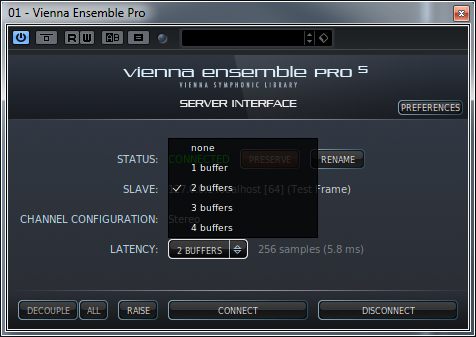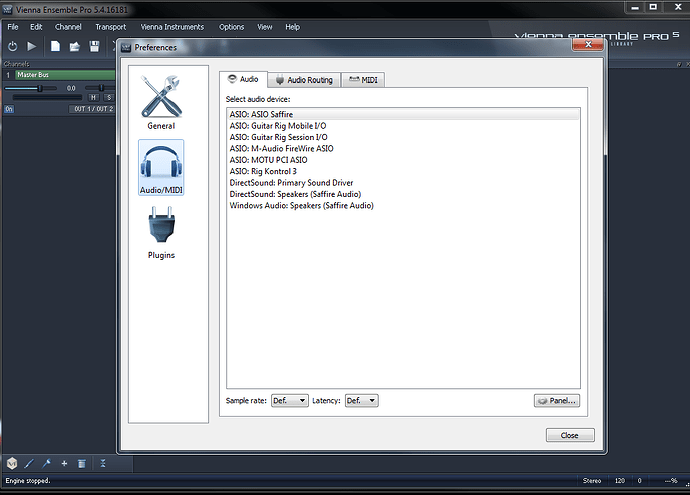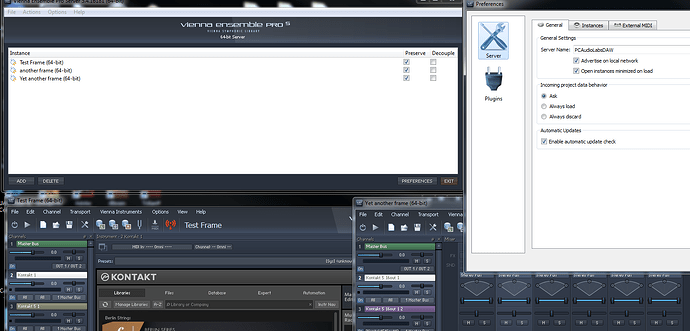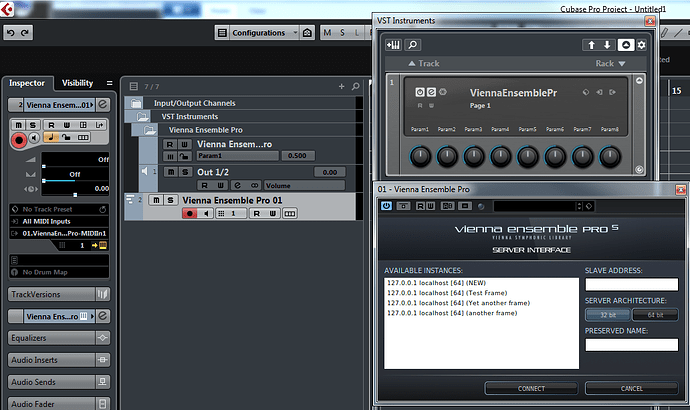Which cannot be recalled with the session. 
I do that right now.
Receptor had a cool little VST that you run in your DAW that ran MIDI and audio back and forth to the Receptor box over wired Ethernet. It made it seemless. I use to do that to lay all the basics down (Cubase 6) then come back later, tweak it, then run it a few more times for multiple takes and layers. All theVST parts wound up on discrete tracks (or lanes) ready for mix down.
There are several modern day ethernet apps that do this - I use Vienna Ensemble Pro for running midi and audio between multiple computers and it works well for hosting a lot of samplers.
Its architecture is basically a mixer though. Definitely not live performance software as we understand C3 to be. Each bank can be recalled from the host computer or kept locked in memory at the slave machines.
Something along those lines could definitely work. VEP can be used on the same machine as the host DAW - doesn’t have to be another piece of hardware. It’s certainly another viable approach means that Cantabile could be used as it is with its midi and audio all being run over a network.
I certainly agree with those with concerns recording what they’ve created in c3. It’s a pain to recreate synth-heavy layers and splits. Tedious and not efficient. Simple Piano or single VSTs might be better just installing in the DAW, but who wants to recreate all their layers and splits—starting over again? I would rather treat c3 like a self-contained instrument. I think you’ve proposed a pretty good solution for that with Vienna Ensemble.
Besides, if you’re using something power hungry like Diva, you will want to record with the most quality and she can burn a lot of cycles. Maybe best to not let her interfere with the DAW.
It’s a pain to recreate synth-heavy layers and splits.
Ain’t it just.
I would be quite excited to see a VEP type approach. And there is one more thing from VEP that’s worth mentioning. Each instance of VEP has its own buffer which is a multiple of the system buffer. If it’s off then it runs at the ASIO setting. You can add up to X4 the buffer which reduces the CPU stress considerably once you’ve finished recording or if you can handle playing with the additional delay.
It’s all delay compensated.
So now the question becomes, would Cantabile run inside a Cantabile network wrapper, or would networking be a feature of C3 or would it be a network version?
Thanks for developing the thoughts on this. I really think it could be a winner for both Brad and the community.
A wrapper would be a viable alternative to VEP. After all, C3 hosts plugins, just like VEP. The only difference is that C3 gets you to the performance of complex setups faster.
I’m going to throw some screen shots up of VEP to let people get a sense of how that system operates.
Firstly, there is a standalone version which is the equivalent of C3 as it stands now. It does not network, It hosts plugins and has a mixer. The shot below shows its pref panel open, equivalent to what we have in C3 ‘options’
Below:
This is the ‘server’ version of VEP. This has no hardware i/o at all. It is addressed purely over a network, even if it’s within the same machine. The MIDI protocol is based on banks and channels, each bank handling 16 channels That means that one instantiation can handle 100’s of channels if required. And, of course, you can use multiple instantiations, each of which can handle the same again.
Its pref panel is open. It’s concerned with the plugin library and how resources are allocated.To the top left you see where instances of what was a single use standalone app now have multiple iterations. In this case, Test Frame, another frame, Yet another frame.
The lower portion of the image shows the Test Frame and instantiations of plugins to the left and a mixer to the right :
Below:
That server will appear in any DAW where it is instantiated into the project like any plugin. You don’t see the GUI of the plugin within the DAW. but it can be ‘raised’ into view by hitting a button within the VEP plugin. In this case, hosted by Cubase. This pic shows the various VEP frames available for connection. The DAW can save the entire contents, as if it were part of the DAW project.
Below:
This shows how every instance can have its buffer multiplied to ease CPU greatly while keeping the instruments ‘live’ and available to play or edit.

So, essentially the same GUI for the app, whether it’s the network version or the standalone.
The essential difference - hardware i/o is handled at the DAW and the server app sends and receives its midi/audio. over the network, either internally or via ethernet.
I hope this opens up some areas of discussion, because the more I think about this approach, the more viable, conceptually and fiscally, it seems to be.
@brad?
I would really like to be able to use Cantabile as a plug-in. As mentioned above, it is hard to get the same sort of splits and layering. Also, I use C3 racks as patch selectors. Many synths I use like the Korg M1 and Wavestation have many, many banks. It’s very time intensive to go and find the location of all the patches I used in the live songs.
I would be ok if it was just a rewire device. I have used the software notation program Sibelius a lot as a rewire device in Sonar.
- Paul
Thanks everyone for the great discussion. I’m deliberately not commenting at this point… I want to see where this discussion goes on its own, but I’m definitely listening. 
@brad
Thanks for popping into this topic 
I think I was off base with the ‘wrapper’ comments. I’m not sure where I was going with that.
So far:
- Cantabile as a VST plugin
- Cantabile with rewire functionality
- Cantabile as a VEP type app which can be run standalone - i.e as Cantabile is right now, or as a server version.
Unless I’ve missed it mentioned, I can’t believe nobody has yet mentioned the fun we could have by having Cantabile running as a plugin hosted in Cantabile!! 
Noooooo- you’ve seen Inception right!
I am staying out of this on purpose to not influence things either way. My live workflow vs. studio workflow are utterly alien to each other.
Hey All,
Thanks everyone for their thoughts on this.
Just to be clear, a VST version of Cantabile could be built without impacting the current standalone version in-so-far as there’s no reason for it to suddenly become more DAW-like, heavier or slower just because there’s now a plugin version of it. Certainly there are some technical hurdles to overcome, but nothing detrimental and nothing that should impact the current standalone version.
Obviously the main aspect of this that appeals to me is the possibiltiy of a broader market. Cantabile’s current target market is fairly niche compared to the computer music industry as a whole, so it would be nice to have a product that appeals to more people.
However… I’m currently not convinced on the benefits of Cantabile as a plugin. I’m not saying there aren’t any, it’s just that I’m not a heavy DAW user so I’ve never really looked at it from that angle and therefore not sure what benefits that really brings.
So some market research is in order, but here’s the critical question:
For someone unfamiliar with Cantabile, what would be the elevator pitch that could get them excited about using Cantabile in their DAW?
I really need to understand this before anything else.
Brad
Well, that’s the true question here - and TBH, I don’t see the big pitch here. I think the unique proposition of making Cantabile a VST plugin would be to re-use our stand-alone setups as instruments in our DAW of choice. But that’s only unique for us Cantabilists - so not a lot of additional market potential for @brad here (even though I’d happily pay some additional fee to have that capability added to Cantabile).
As for the use for non-Cantabilists: there are already a number of plugins that can host other plugins:
- Bidule
- Metaplugin
- Minihost Modular
- Magma
All of these allow you to create presets out of individual VST plugins chained together - some difference in the degree of complexity they allow.And TBH, all of these are pretty niche - too complex for the casual user, mostly used by sound designers and a few sophisticated power users. Not really a mass market out there…
So even though I love Cantabile to death - and I would really appreciate being able to use the “instruments” I create in Cantabile in Cubase - I don’t see much beyond a niche market for the plugin version outside the Cantabile community.
And for us Cantabilists, I’d actually prefer the simple solution of implementing ReWire as a connection - probably a lot easier than wrapping Cantabile into a plugin, and it would allow me pretty much all I’d need to record my Cantabile instruments.
Just my 0.02 EUR
Cheers,
Torsten
I think I agree with Torsten and his well put comment. I don’t have a burning need for this myself, but I would not say don’t do it! 
Well, I agree with @Derek and @Torsten . Change my mind.
It certainly would be easier to record having my C3 patches/racks/songs in one place. Meh. I already do that MIDI and S/PDIF. What is the Value Proposition–the unique “nobody else can do _____” about having Cantabile as a VST. I really want to grow @brad’s niche here, but what benefit would Joe Frisbee record producer (a teenager with a Mac) get from a Cantabile as a VST that warrants a significant investment of Brad’s time? Cross platform? Easier _______? Better _______? Faster ________? As they say, Fast, Cheap, and Easy. You get to pick two. And don’t say anything sexist.
A broader market is an understatement. It’s a huge market. it’s a cross platform market.
And it’s a market which introduces those who may never have conceptualized the creative impetus, stimulus and inspiration that results from gaining fast access to plugins in configurations that, in most DAW situations, are just a PITA to create.
This is the first thing one notices when Cantabile enters your world… how FAST you can get playing these marvelous configurations.
Not only does the Cantabile plugin serve the interests of existing Cantabile users, it also brings non users into the sphere of ALL versions of Cantabile.
Those who claim they can do this via MIDI and SPDIF are not being complete in their overview. I do that now, and it is a FAR cry from what a plugin would achieve.,
For one thing, you can run multiple instances of a plugin.
For another, you can run on one machine.
For another you can render or freeze the output easily.
For another, the entire project is recalled in one go.
For another you can have multiple outputs without the need for expensive interfaces with ADAT ports.
I could expand on the huge difference between hardwiring an external computer and a host, but the above suffices for my point.
We have already discussed the benefits for existing users who have put time and effort into perfecting patches. Those setups now become available with tremendous speed and playability. Playability . This is a key word.
Cantabile is what it is because of the playability it offers to the user. That’s why it was targeted at live performers. The idea is to get you the fastest and most reliable way to stand in front of an audience and make great sounds, utilizing the truly astounding palette of plugins that 21st century developers have given us. And recording into a DAW is simply the modern studio - and in that environment, one performs. If you record in your studio, at some point, you are dealing with performance.
Brad is not a heavy DAW user. OK. I am. Also have a fair smattering of live performance under my (slightly wider than it used to be) belt. Do I want the level of playability and ease of access to my configurations when I’m playing live or in the studio? You bet I do. The criteria are identical. I want to be able to get to the meat and potatoes as quickly as possible - and be inspired by these Cantabile creations when I have my composing hat on.
Cantabile as a plugin will create:
- A potentially massive new market with a new income stream, protecting Cantabile’s future development.
- Opens creative doors for existing and new users, and obviates cludgey hardware hookups which cannot be recalled with ease, or allow for multiple use
- Gets around the issue of reproducing the studio sound in a live situation, or vice versa.
- Has no technical downside, as confirmed here by Brad. Absolutely nothing to lose - especially with the Mac market opening to Cantabile users soon. Cantabile could become the go to software for moving setups between different studio platforms and the live stage.
As a footnote, I was also very excited by the network approach, as marketed successfully by Vienna in their VEP product. I own it, use it, and it handles large orchestral templates well. But is it a creative environment like Cantabile? Absolutely not. It is a lump with a mixer. Cantabile’s architecture could really bite into that market too.
So it seems there’s two competing views here.
and
I guess one way to find out would be to try to crowd fund it.
Thunderdome…2 men enter, 1 man leaves.
And TBH, all of these are pretty niche - too complex for the casual user, mostly used by sound designers and a few sophisticated power users. Not really a mass market out there…
I’m sure he’ll correct me if I’ve misunderstood but I read that as Torsten saying that the plugins like Bidule and Metaplugin are not for the faint hearted. I agree.
And that’s why Cantabile does not fit into that niche. I think it’s very important that we’re precise here. We wouldn’t want to be talking at cross purposes. ![]()
So even though I love Cantabile to death - and I would really appreciate being able to use the “instruments” I create in Cantabile in Cubase - I don’t see much beyond a niche market for the plugin version outside the Cantabile community.
I see this quite differently. I see this as a major profile builder for Cantabile. I think it would become part of the toolbox of film composers in the same way VEP has, but with the added bonus that Cantabile is a vastly superior performance environment. I could continue to write lists of plus points, but I have seen that there is a real demand for a portable, cross platform, environment that helps bridge the gap between collaborators using different DAWs, especially in the film music world.
Cantabile is a niche product as it stands. Any development, regardless of the approach taken (rewire, plugin, network) is going to break that niche.
Cantabile as a plugin would be my favored option. Any VEP user can then use their networking utility with Cantabile instantiated within VEP. No point in reinventing the wheel,
I would certainly actively promote this to friends and acquaintances in the LA area.
‘Playability’ is not a niche requirement. Few DAWs offer such an experience as they are modeled on different criteria.


